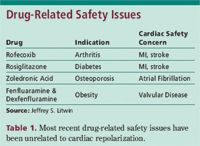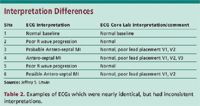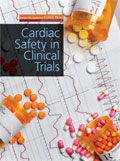Cardiac Safety: Beyond QT
How does ECG reading in clinical research compare to a healthcare interpretation?
If you talk to a clinical cardiologist about cardiac safety, it is highly unlikely that the letters "QT" will ever be uttered. On the other hand, if you speak to someone in the pharmaceutical industry about cardiac safety, it is highly likely that the only thing mentioned will be the effect of a drug on cardiac repolarization and how the measurement of the QT interval is essential to characterizing that risk. Although the fundamental rules for measurement of electrocardiogram (ECG) intervals and overall ECG morphology interpretation should be the same whether an ECG is recorded from a patient being evaluated by a healthcare professional or from a healthy subject involved in a clinical drug trial, this is generally not the case.
In a healthcare setting the physician is generally presented with a patient who is following up for a known medical condition or who has an acute illness. If an ECG is performed, the physician will primarily look for morphologic features that may represent cardiac abnormalities. The interval duration measurements will be examined only briefly, and may lead to the conclusion that first degree AV block or bundle branch block is present, but only an extremely long QT interval is likely to catch the treating physician's attention. In addition, many ECGs are read with hedging terms such as "possible," "consider," "cannot rule out," or "probable" that offer some medical-legal protection.

DAVID GOULD/GETTY IMAGES
Pharmaceutical sponsors of drug research generally utilize ECGs for the following purposes:
- Screening, selection, and enrollment of study participants.
- Assessment and monitoring of cardiac safety of the investigational drug through evaluation of changes in ECG morphology (e.g., infarcts) and interval duration measurements (with emphasis on changes in QTc).
- Assessment of the efficacy of the investigational drug or intervention in cardiovascular trials.
In addition to the above, indirect benefits accrue to subjects who enroll in clinical trials. The screening ECG recorded for a clinical trial may be the first ECG ever obtained for a subject, and may lead to the detection of previously undiagnosed structural or electrical cardiac diseases. Serial ECGs performed during a clinical trial may also lead to the recognition of progression of pre-existent cardiac disease that is unrelated to the clinical trial.
ECG core laboratories in clinical trials
One of the most important, if not the most important, responsibilities of the ECG core laboratory is to determine whether a subject in a clinical trial has developed a new ECG finding while receiving treatment with the investigational drug. The accurate assessment of interval duration measurements, particularly the QT interval, has become one of the most important factors to consider in drug development, and for many it is the only factor that is considered when determining which cardiac safety evaluations will be performed in a clinical program. The International Conference on Harmonization E14 (ICH E14)1 guidelines outline the criteria by which new drugs are assessed for the potential of producing QT prolongation, and define the threshold for QTc prolongation which raise concerns about triggering a potentially lethal arrhythmia known as "torsade de pointes."
However, there has been very little regulatory guidance, and very little pharmaceutical industry attention paid to the ECG assessment of cardiac safety issues unrelated to QTc prolongation. This trend has continued despite the fact that most of the headline grabbing, drug-related safety issues of the last few years have been due to cardiovascular events unrelated to cardiac repolarization (QTc prolongation). Table 1 illustrates some of these high profile examples.

Table 1. Most recent drug-related safety issues have been unrelated to cardiac repolarization.
Clinical research vs. clinical practice
ECG processing in clinical research includes obtaining, measuring, interpreting, storing, reporting, and analyzing ECG data. Most of these are common features for both research and development as well as clinical practice. However, ECG reading for clinical research does have some important distinguishing characteristics that make the process different from that of clinical practice.
Compliance with regulatory guidelines. Regulatory compliance is not required for clinical ECG interpretation, but is of the utmost importance in clinical trials from which results will be submitted to international regulatory agencies.
Accurate, reproducible Interval Duration Measurements (IDMs). Unlike ECG reading in clinical practice, where small errors in measurement of the PR, QRS, RR, or the QT intervals are unlikely to be of any significance, accurate measurement of IDMs in clinical research is absolutely critical to assess a drug's cardiac safety profile. As stated above, the identification of small changes in the corrected QT interval is currently the cardiac safety issue of greatest concern to drug developers, but is not the focus of this article.
Highly reproducible, blinded, consistent ECG interpretation. While consistent ECG reading is important in clinical ECG analysis, it is critically important for ECG interpretation in clinical research. Consistent interpretation of ECGs, ideally by a core laboratory with a very small number of expert cardiologists, is necessary to avoid the reporting of spurious "changes" in ECG findings. False positive ECG changes that are reported during a study could be falsely attributed to the investigational drug but, instead, would actually be due to inconsistencies in the ECG interpreter's style. A good example would be the interpretation of old myocardial infarction. In clinical practice it is common for cardiologists to use many different terms to report an old myocardial infarction (MI), such as: an MI; a Possible MI; a Probable MI; or some other variation. This is a completely acceptable practice in a clinical setting where the physician interpreting the ECG wants to hedge their interpretation in order to ensure that an important finding is not overlooked. It is, in fact, common practice to err on the side of caution in an attempt to prevent or at least reduce the possibility of medical-legal complications. However, this type of interpretation could wreak havoc in a clinical study database where it would interfere with the detection of new events during drug exposure, and would make it impossible to determine if there was a new event "on drug."
The appearance of serial ECGs may vary, and Q wave myocardial infarctions may seem more or less evident on serial ECGs due to subtle changes in lead position, subject positioning, or heart rate. In clinical practice, the "appearance" and "disappearance" of Q waves may lead to inconsistent ECG interpretations, but will generally have no effect on patient care. In contrast, during a clinical trial, the spurious report of a new MI which is in fact due to a slight change in ECG axis or lead positioning can have tremendous consequences both for the clinical trial and for the entire drug program. Several examples of ECGs which were nearly identical, but had inconsistent interpretations are presented in Tables 2 and 3. The differences between the ECG core laboratory interpretations and the interpretations of the investigators and the clinical sites are also addressed.

Table 2. Examples of ECGs which were nearly identical, but had inconsistent interpretations.
Based on the ECG interpretations provided by the sites, the two clinical research subjects shown in Tables 2 and 3 would both have been characterized as having ECG findings consistent with new myocardial infarction that occurred on treatment. Depending on the study criteria, these subjects could have been sent to a data safety monitoring board for review and/or had more definitive and expensive tests done to determine whether an asymptomatic infarct occurred between study visits. However, the ECG core laboratory's reports of the same subjects' ECGs have shown no abnormalities and no change from baseline, thus abrogating the need for further work up and review. It is very important that ECG interpretation in clinical trials be done consistently, with strict adherence to clear interpretation guidelines, in order to allow for the detection of true drug-related effects. The use of a core ECG laboratory for ECG interpretation is a common mechanism to ensure such consistency.

Table 3. Subjects would have been classified as having ECG findings consistent with new myocardial infarction that occurred on treatment.
Regulatory issues
The focus of this article has been the importance of consistent ECG morphology interpretation, which is best accomplished by ECG centralization. Another article in this supplement addresses the importance of centralization, but it would be remiss to not point out another frequently overlooked benefit of centralization. Centralization of ECG evaluation can prevent situations like the following example. In a "Warning Letter: Investigator Didn't Review Screening ECGs"2 a clinical investigator failed to review the screening electrocardiograms (ECGs) for the majority of the 58 subjects the FDA audited, according to a warning letter. The FDA says it cannot tell how the investigator could have adequately determined that the subjects were eligible for inclusion in the trial "given that the ECGs were not documented as having been reviewed prior to the randomization visit."
Interpretation challenges
ECG interpretation in clinical research is challenged by the lack of consensus on:
- The criteria which determine what is a normal vs. abnormal ECG, and what are normal ranges for IDMs.
- The clinical relevance of different ECG abnormalities and/or changes (e.g. progressive prolongation of a PR interval in first degree AV block or of the QRS interval with a bundle branch block).
- The relevance of new or worsening findings in normal healthy volunteers vs. patients with pre-existing illness and/or cardiac disease (see clinical relevance section below).
- The significance of trivial ECG changes during serial ECG comparisons. For instance, changes in IDMs may be minimal, but may be sufficient to cross a chosen threshold. Example: a normal ECG with a PR interval duration of 199 milliseconds (msec) that becomes abnormal when the PR interval on the next ECG measures 201 msec, resulting in a report of a new abnormality and, if comparisons are requested, a finding of "deterioration" (see comparison to baseline section below).
ECG core labs should have standard criteria for normal IDMs for both adult and pediatric studies, but should also have the flexibility to accommodate sponsor requests for protocol alerts related to either safety or inclusion/exclusion criteria.
An example of the clinical importance of standardization of interpretation is exhibited in an article by Vijayaraghavan, et al.3 The study included 5,277 patients from 51 hospitals participating in the Canadian ACS Registry who were hospitalized with an acute coronary syndrome (ACS) and had an interpretable initial ECG. Core lab ECG interpretation was blinded to site interpretation and outcomes. Patients with core-lab-defined ST-elevation and cardiac marker elevation (n = 1,202) not classified as ST-elevation by the site were less likely to receive acetylsalicylic acid (ASA) (90% vs. 96%, P <0.0001), heparin (91% vs. 95%, P <0.04), and reperfusion therapy (14% vs. 76%, P <0.0001) than patients for whom there was agreement that ST-elevation was present. After adjusting for other validated prognostic factors, site-unrecognized ST-elevation was independently associated with higher mortality (odds ratio = 2.21; 95% CI, 1.46–3.36; P <0.001). The authors concluded that in patients with ACS, there was only moderate agreement between core lab and site interpretation of the initial ECG. Site-unrecognized ST-elevation myocardial infarction was associated with underutilization of evidence-based therapies and increased one-year mortality.
Clinical relevance
In the opinion of the author, it is not appropriate for an ECG core laboratory to determine clinical relevance, as the core laboratory is blinded to all clinical information. It is difficult to determine the clinical relevance of various ECG abnormalities or ECG changes solely based on a single resting ECG tracing. This dilemma is only aided slightly by the addition of serial ECG comparisons. Clinical relevance is just that, a clinical decision—not a decision made in a vacuum or based on the interpretation of a single piece of evidence. The clinical relevance of a particular finding must be judged in the context of the patient's prior history, current symptoms, and physical findings. Therefore, if a determination of the clinical relevance of any particular ECG abnormality is desired, the investigator at the study site should determine that "clinical" information is needed to determine "clinical" significance.
In addition, the clinical significance of different ECG findings is dissimilar in diverse populations and often cannot be dictated by rules. For example:
- Flat T waves are generally not felt to be clinically significant, but if a patient is experiencing chest pain at the time the T waves become flat, that would be clinically significant. The core ECG lab would be blinded to any patient symptoms and site reliance on a core laboratory determination that this finding was not significant could have an adverse effect on patient care.
- A change in the heart rate from 60 bpm to 90 bpm (both within the normal range) may be clinically more important than a change in the heart rate from 99 bpm to 101 bpm, however the latter example results in a new diagnosis of sinus tachycardia.
In most cases, clinically relevant ECG abnormalities or ECG changes should be defined as those that required medical attention due to their prognosis or treatment (e.g., new MI, new left bundle branch block (LBBB), or new onset atrial fibrillation). A subclass of this group would include clinically relevant ECG abnormalities that are significant enough to initiate active medical follow-up or that require changes in the subject's management. These changes would be classified as medical or ECG alerts (e.g., acute MI). Serious findings warrant expedited notification of all appropriate medical personnel (including both on-site investigators and safety officers) identified by each study protocol. When faced with these alerts, sites should follow normal and prudent procedures to ensure patient safety, and should not delay appropriate care due to the fact that the patient is in a clinical trial.
Comparison to baseline
Comparison between serial ECGs recorded during a trial is another area of contention and inconsistency. There is little agreement on which (or how many) ECGs should serve as the baseline comparator for a study, or whether comparisons should be made to baseline ECGs or to subsequent ECGs recorded during a trial. In addition, when multiple baselines are collected it is possible that some may have different morphology determinations. This prompts the question as to which of the baseline ECGs is the "true" comparator, since morphologic findings, unlike interval duration measurements, cannot be mathematically averaged.
As stated previously, slight changes in a measurement can result in an ECG crossing a pre-defined boundary and can result in a comparison of "deteriorated" or "improved." Some examples are:
- A small increase in the QRS duration may result in a "deterioration" from incomplete LBBB to complete LBBB.
- A small increase in the PR interval may result in the manifestation of a first degree AV block and thus a "deterioration" in conduction.
- A small decrease in heart rate may result in sinus tachycardia improving to normal sinus rhythm.
These rule related "deteriorations" or "improvements" do not aid the clinical site, the subject, or the collection of the study data, and may simply result in confusion, added expense, and delays.
Another major problem with performing ECG comparisons arises when ECGs are delivered to the ECG core laboratory out of sequence. If the comparator ECG is not available when later ECGs are evaluated, a comparison cannot be made. If the comparator ECG subsequently becomes available, the interpretation of all subsequent ECGs will need to be revised, resulting in added expense, delay, and potential for errors.
For these reasons it is preferred not to include comparisons in ECG interpretations during clinical trials. Instead, rely upon the use of clinical alert criteria, which allow for notification of site and sponsor whenever a concern for subject safety arises. The ECG criteria which trigger an alert may be customized depending on the details of the study population, drug being investigated, or needs of the sponsor and sites.
Diabetes guidance: a shift in regulatory focus?
There has been a great deal of attention paid to the risk of diabetes medications and their potential to increase the risk of cardiovascular mortality. In December 2008, the FDA issued "Guidance for Industry: Diabetes Mellitus—Evaluating Cardiovascular Risk in New Antidiabetic Therapies to Treat Type 2 Diabetes"4 which "provides recommendations for the development of drugs and therapeutic biologics regulated within the Center for Drug Evaluation and Research at the Food and Drug Administration (FDA) for the treatment of type 2 diabetes mellitus. Specifically, this guidance makes recommendations about how to demonstrate that a new antidiabetic therapy to treat type 2 diabetes is not associated with an unacceptable increase in cardiovascular risk." This marks a broadening of regulatory focus on cardiac safety issues to include the evaluation of new drugs for cardiovascular risks unrelated to QTc prolongation.
The number of subjects needed for a clinical trial to comply with the guidance is quite large and this will result in a major paradigm shift in how diabetes studies are conducted. In the past, the majority of the subjects in Phase II and Phase III diabetes studies were relatively healthy, and the study endpoints were related to the degree of the glucose regulation which was achieved. In contrast, the new guidance calls for the evaluation of clinical endpoints of cardiac risk such as non-fatal myocardial infarction, non-fatal stroke, and cardiovascular mortality—known as Major Adverse Cardiovascular Events (MACE) criteria. This requirement for cardiovascular endpoint data will result in larger and longer Phase II and Phase III trials, and will require the inclusion of subjects at high risk for cardiovascular events. Without these higher risk subjects, meeting the new requirement of showing a risk ratio of <1.8, but preferably <1.3, would require sample sizes that would make the conduct of these trials unfeasible due to size and cost.
The identification of MIs that have occurred between visits will be essential to ensure that no event is missed. These MIs may have been "silent" MIs (MIs which are associated with no symptoms or with such atypical symptoms that the subject did not seek medical attention at that time). It is thought that silent MIs occur more frequently in the diabetic population, so if one were to count only symptomatic, clinically recognized MIs, the number of subjects required for the trial would increase even further. It is thus important to be able to identify "silent MIs" precisely, but as described above, use of site generated ECG interpretations may lead to the under or overestimation of events. Once identified, a more formal evaluation will need to be carried out (e.g., wall motion evaluation by echocardiography or stress testing), with the attendant costs and complexities. The type of consistent reading performed by an ECG core lab is likely to ensure that all relevant ECG findings are noted and those "new findings" that are not relevant (or that are entirely due to inconsistent ECG interpretation) do not lead to additional procedures and cost.
Summary
To date, the use of an ECG core laboratory in clinical research has generally been limited to the assessment of QT interval duration, and there has been minimal centralization when QT prolongation has not been found in early phase studies. There are significant benefits to centralization in regard to ECG morphology interpretation which have not been fully explored. The issuance of new guidance for diabetes studies may induce more sponsors to undertake the centralization of ECGs in order to obtain the most consistent and accurate data in regard to cardiovascular events noted on ECGs. Hopefully, this collaboration will lead to a better understanding of how standardized processes that have been developed specifically for clinical research would be of benefit in many more studies in determining the cardiac safety of investigational drugs.
Jeffrey S. Litwin, MD, is Chief Medical Officer, ERT, Philadelphia, PA, e-mail: JLitwin@ert.com.
References
1. ICH Guideline E14, 2005, The Clinical Evaluation of QT/QTc Interval Prolongation and Proarrhythmic Potential for Non-antiarrhythmic Drugs. http://www.ich.org/LOB/media/MEDIA1476.pdf.
2. "Warning Letter: Investigator Didn't Review Screening ECGs," Clinical Trials Advisor, (14) 7 (2009).
3. R. Vijayaraghavan, A. T. Yan, M. Tan, D. H. Fitchett, A. A. Georgescu, Q. Hassan, A. Langer, and S. G. Goodman, "Local Hospital vs. Core-Laboratory Interpretation of the Admission Electrocardiogram in Acute Coronary Syndromes: Increased Mortality in Patients with Unrecognized ST-Elevation Myocardial Infarction," European Heart Journal, 29 (1) 31-37 (2007).
4. Food and Drug Administration, Guidance for Industry: Diabetes Mellitus — Evaluating Cardiovascular Risk in New Antidiabetic Therapies to Treat Type 2 Diabetes (FDA, Silver Spring, MD, December 2008).
Unifying Industry to Better Understand GCP Guidance
May 7th 2025In this episode of the Applied Clinical Trials Podcast, David Nickerson, head of clinical quality management at EMD Serono; and Arlene Lee, director of product management, data quality & risk management solutions at Medidata, discuss the newest ICH E6(R3) GCP guidelines as well as how TransCelerate and ACRO have partnered to help stakeholders better acclimate to these guidelines.
Putting Collective Insights Into Action to Advance Cancer Care: Key Examples From ASCO 2025
June 27th 2025At ASCO 2025, clinical operations leaders gained critical insights into how AI tools, bispecific antibodies, and evolving treatment paradigms are reshaping trial design, endpoint selection, and patient stratification.
